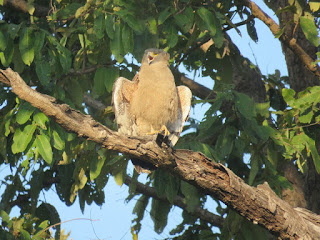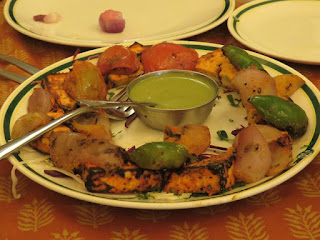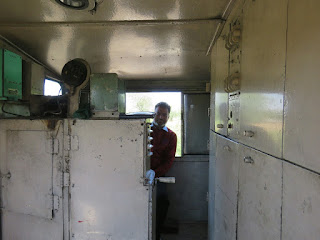Ramesh tries hard to find a tiger and we watch another possible position as we eat our picnic breakfast of boiled eggs and bread and butter. Still the Crested Serpent Eagles line up, one of them doing a spot of sunbathing just above the track. Eventually time is up and we have to turn back towards the gate. We pass one last eagle, staring inscrutably at us from about thirty metres away. Lunch is aloo saag, with two types of dal, rice and chapattis. We enjoy it very much.
The afternoon safari heads for a different area of the park. On the way we stop to pick up another guide who needs a lift to the park entrance. Before we even get to the park we see a tree absolutely covered in bees nests and then several Griffon Vultutures circling. We pull up on a ford over a dry riverbed and see that there are dozens of vultures assembled down in the riverbed. The guide tells us that there is a deer carcass there. To the side of the river there are some dead tree stumps covered in vultures rather evoking images of Walt Disney's Jungle Book. Ramesh calls "Chalo" (let's go) and we move on to the park gate to register. The other guide hops out and we set out on a straight and well surfaced road across the buffer zone. There is birdlife everywhere including numerous green bea eaters, several shrikes, an Indian Roller, posed beautifully on a dead tree and a small group of birds that even Ramesh has to look up in the book. They are plains martins, not a regular visitor to this area.
At the second gate we check in and follow the track into the forest. We soon come in sight of a gaggle of Gypsies. One of the other guides tells Ramesh that two bears have been seen. We park up to see what transpires. Suddenly Ramesh hisses "Tiger!" D turns to see the rear quarters and tail of a large tiger moving off the track behind us into the bush. R is not quite quick enough, while D has no time to get a photo. Two of the other guides instruct their drivers to drive quickly to the spot which displeases Ramesh greatly as he thinks that there is a good chance that the tiger might reappear. We wait for half an hour or so, while everybody else gets bored and moves on. The tiger does not come back but we have a good view of a tree that attracts some very interesting birds, including two types of barbet and some plum headed parakeets.
We drive on and see a lot more birds including pheasants, jungle fowl, emerald doves and best of all a colony of Griffon Vultures roosting high up on a cliff. Ramesh calls a halt as he has spotted a very rare bird. It is a Blue Bearded Bee Eater, hunched up against a tree at some considerable distance. His eyesight and ability to spot birds is just phenomenal. The bird's position and the light are not great for photography but D gets a shot of a kind. We are shown a tree laden with weaver bird nests. There are also plenty of monkeys and deer to distract us. As we turn for home we cross a river bed where a peacock is displaying his tail to great effect. After a couple of minutes he turns to give the perfect angle for a photo. This is a great finale to a good afternoon's birding. Driving through the buffer zone we get great sightings of Grey Hornbills.
On the way home we stop to buy sweets at a shop as a present for Mrs Ramesh and pick up their daughter. It is dark by the time we get in and we have lots of photos to look through with a good proportion getting the delete treatment. There are some good survivors though. Supper smells great, and after soup we tuck in to a really tasty Chicken Biryani. D sits down with Ramesh to sort out the bill. Last year we were exceptionally lucky, with two tiger sightings and more elephants than we could count. This time the results were more about birds but we still had a most enjoyable visit. Ramesh is hoping to build a bigger place soon to allow him to expand his business. He is just waiting for the legal title to the land to be finalised. We need no rocking to sleep tonight.

























































